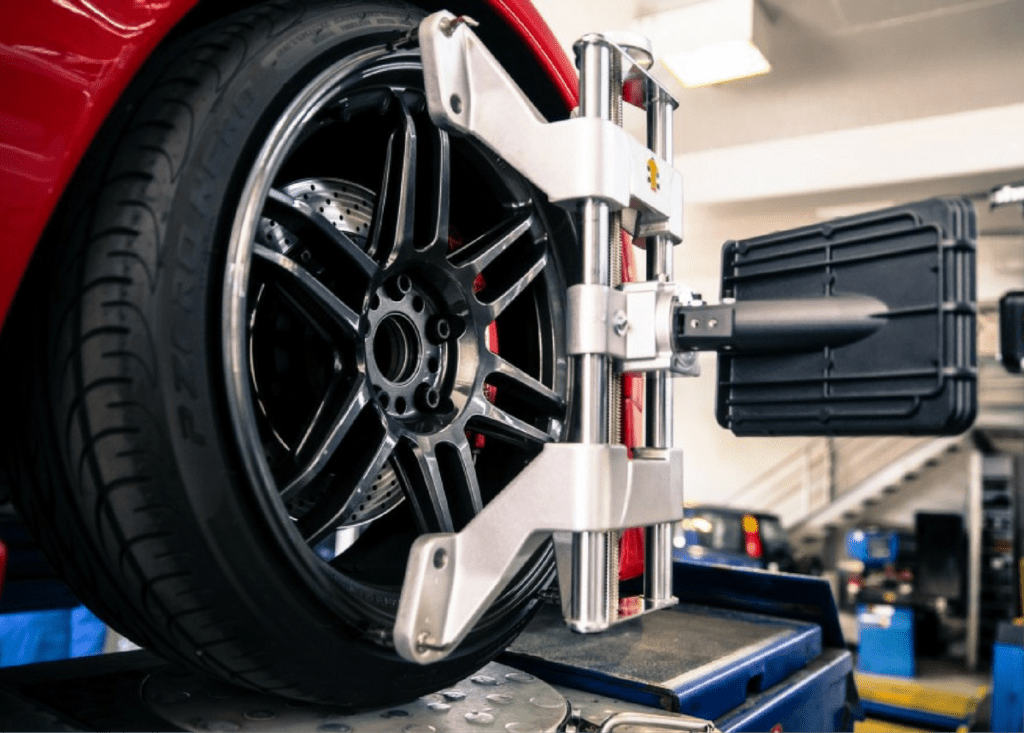
Ensuring your car’s tires are correctly aligned is not just about a smooth ride; it’s about your safety on the road. When we talk about well-aligned tires, we mean that all your tires are parallel to each other and are pointing in the same direction, providing you with a secure and protected driving experience.
Wheel alignment should be a regular part of your car maintenance routine. It offers several benefits, like
Today, we will dive into the thorough understanding of wheel alignment. We’ll explore its benefits, its importance in your car’s maintenance schedule, and why you should be excited about it. So, stay tuned; we are about to explore!
Tire alignment is a mechanical adjustment of your car’s suspension to improve the direction and angle of the tires. Alignment is an important element of vehicle servicing that should be completed at regular intervals.
Professionals measure tire alignment in three central angles.
Tire alignments are essential because tires that are out of alignment can cause issues such as making your tires wear out quickly or unevenly and lead to a less pleasant experience of driving or riding in your car. These issues can escalate quickly, emphasizing the urgency of regular tire alignment to maintain your vehicle’s performance and safety.
Several signs indicate that your tires are misaligned. Be vigilant; if any of the following indicators are obvious while driving, you must rush for a tire alignment.
Usually, tires of the same type, age, and tread patterns wear evenly. But if you notice any uneven wear patterns, like excessive wear on the inside or outside edges of the tires, it’s time to rush for a tire alignment.
If your car is pulling to one side while driving on a straight road, it could be a sign of misaligned tires. When pointing the car in a straight line, a poorly aligned tire will cause the car to drift to one side.
One quick way to catch off-center tires is via your steering wheel. Well-aligned tires allow the steering wheel to center and appear in a normal position when you’re driving straight. But with misaligned tires, you might notice your steering wheel maintaining a slight tilt.
Misaligned tires can cause vibrations or shaking of the vehicle, especially at higher speeds. This happens when two or more tires are pointed away from each other.
Misaligned tires can affect your vehicle in several ways:
Misaligned tires can increase the rolling resistance of your tires, which leads to decreased gas mileage.
Misalignment is also responsible for uneven tire wear. It shortens the lifespan of your tires and requires more frequent replacements.
Misaligned tires can affect the handling and stability of your vehicle, especially during turns or sudden maneuvers.
The compromised handling and stability resulting from misaligned tires can increase the risk of accidents, especially in emergencies.
These issues can escalate quickly. Regular alignment checks can help prevent these issues with safety.
There is no rule of thumb to define your alignment needs. Usually, professionals recommend getting your tire alignment done after every travel of 6000 miles or once a year at least. But again, the frequency at which your tires may need alignment depends on various factors like the type of tires and your type of driving. Also, if you get your tires replaced, you must opt for alignment, not for safety but for the improved life span of the tires.
When you take your car for an oil change or general servicing, it would be best to seek advice from professionals. They will be able to say confidently if you’re due for an alignment.
There are 3 different types of tire alignment that you need to consider, namely front-end, thrust, and four-wheel alignment. Let us quickly review these.
Front-end alignment adjusts the angles of the two front wheels for improved handling and reduced fuel consumption. It’s a common and effective alignment type for front-wheel drive vehicles.
Thrust alignment is recommended for all vehicles with rear solid axles. This alignment squared all four tires of your car with each other. Thrust alignment provides a better result on the road in terms of tire wear, fuel economy, and safety.
The four-wheel alignment is suitable for vehicles with four-wheel independent suspensions and front-wheel drive vehicles that have adjustable rear suspensions. This alignment allows for measuring and positioning the rear axle angles along with front and thrust alignment features.
Generally speaking, it takes up to an hour to perform a complete alignment. But it may vary! If the mechanic finds any damaged or worn-out parts in the suspension system, the duration may expand. Similarly, the four-wheel alignment service will take more time than simple front-end alignment.
Tire alignment is an intricate task that trained professionals must do. People usually mix tire balancing with alignment, but these two are not the same. Tire balancing focuses on ensuring the tire, tire rim, and valve rotate on the vehicle without vibrating. In contrast, alignment is all about the direction of the tires and their angle of contact on the road.
We highly recommend drivers keep their tires well-aligned for a safe and smooth journey. How often you need an alignment or how long alignment takes may vary, but if your vehicle is due for its annual alignment, get it done by a professional technician who uses the latest tools and technology.